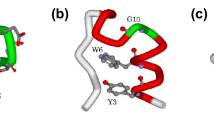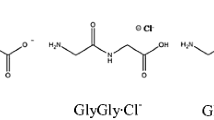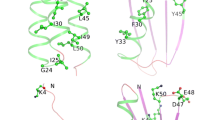Abstract
Single amino acid potential (SAAP) would be a prominent factor to determine peptide conformations. To prove this hypothesis, we previously developed SAAP force field for molecular simulation of polypeptides. In this study, the force field was renovated to SAAP3D force field by applying more accurate three-dimensional main-chain parameters, instead of the original two-dimensional ones, for the amino acids having a long side-chain. To demonstrate effectiveness of the SAAP3D force field, replica-exchange Monte Carlo (REMC) simulation was performed for two benchmark short peptides, chignolin (H-GYDPETGTWG-OH) and C-peptide (CHO-AETAAAKFLRAHA-NH2). For chignolin, REMC/SAAP3D simulation correctly produced native β-turn structures, whose minimal all-atom root-mean-square deviation value measured from the native NMR structure (except for H) was 1.2 Å, at 300 K in implicit water, along with misfolded β-hairpin structures with unpacked aromatic side chains of Tyr2 and Trp9. Similar results were obtained for chignolin analog [G1Y,G10Y], which folded more tightly to the native β-turn structure than chignolin did. For C-peptide, on the other hand, the α-helix content was larger than the β content on average, suggesting a significant helix-forming propensity. When the imidazole side chain of His12 was protonated (i.e., [His12Hip]), the α content became larger. These observations as well as the representative structures obtained by clustering analysis were in reasonable agreement not only with the structures of C-peptide that were determined in this study by NMR in 30% CD3CD in H2O at 298 K but also with the experimental and theoretical behaviors having been reported for protonated C-peptide. Thus, accuracy of the SAAP force field was improved by applying three-dimensional main-chain parameters, supporting prominent importance of SAAP for peptide conformations.










Similar content being viewed by others
References
Ramachandran GN, Sasisekharan V (1968) Conformation of polypeptides and proteins. Adv Protein Chem 23:283–437. https://doi.org/10.1016/S0065-3233(08)60402-7
Head-Gordon T, Head-Gordon M, Frisch MJ et al (1991) Theoretical study of blocked glycine and alanine peptide analogues. J Am Chem Soc 113:5989–5997. https://doi.org/10.1021/ja00016a010
Shang HS, Head-Gordon T (1994) Stabilization of helices in glycine and alanine dipeptides in a reaction field model of solvent. J Am Chem Soc 116:1528–1532. https://doi.org/10.1021/ja00083a042
Gould IR, Cornell WD, Hillier IH (1994) A quantum mechanical investigation of the conformational energetics of the alanine and glycine dipeptides in the gas phase and in aqueous solution. J Am Chem Soc 116:9250–9256. https://doi.org/10.1021/ja00099a048
Hudáky I, Hudáky P, Perczel A (2004) Solvation model induced structural changes in peptides. A quantum chemical study on Ramachandran surfaces and conformers of alanine diamide using the polarizable continuum model. J Comput Chem 25:1522–1531. https://doi.org/10.1002/jcc.20073
Wang ZX, Duan Y (2004) Solvation effects on alanine dipeptide: A MP2/cc-pVTZ//MP2/6-31G** study of (Φ, Ψ) energy maps and conformers in the gas phase, ether, and water. J Comput Chem 25:1699–1716. https://doi.org/10.1002/jcc.20092
Iwaoka M, Okada M, Tomoda S (2002) Solvent effects on the φ-ψ potential surfaces of glycine and alanine dipeptides studied by PCM and I-PCM methods. J Mol Struct THEOCHEM 586:111–124. https://doi.org/10.1016/S0166-1280(02)00076-3
Iwaoka M, Yosida D, Kimura N (2006) Importance of the single amino acid potential in water for secondary and tertiary structures of proteins. J Phys Chem B 110:14475–14482. https://doi.org/10.1021/jp062196g
Smith LJ, Fiebig KM, Schwalbe H, Dobson CM (1996) The concept of a random coil. Residual structure in peptides and denatured proteins. Fold Des 1:R95–R106. https://doi.org/10.1016/S1359-0278(96)00046-6
Fiebig KM, Schwalbe H, Buck M et al (1996) Toward a description of the conformations of denatured states of proteins. Comparison of a random coil model with NMR measurements. J Phys Chem 100:2661–2666. https://doi.org/10.1021/jp952747v
Iwaoka M, Tomoda S (2003) The SAAP force field. A simple approach to a new all-atom protein force field by using single amino acid potential (SAAP) functions in various solvents. J Comput Chem 24:1192–1200. https://doi.org/10.1002/jcc.10259
Iwaoka M, Kimura N, Yosida D, Minezaki T (2009) The SAAP force field: development of the single amino acid potentials for 20 proteinogenic amino acids and monte carlo molecular simulation for short peptides. J Comput Chem 30:2039–2055. https://doi.org/10.1002/jcc.21196
Takei T, Urabe Y, Asahina Y et al (2014) Model study using designed selenopeptides on the importance of the catalytic triad for the antioxidative functions of glutathione peroxidase. J Phys Chem B 118:492–500. https://doi.org/10.1021/jp4113975
Dedachi K, Shimosato T, Minezaki T, Iwaoka M (2013) Toward structure prediction for short peptides using the improved SAAP force field parameters. J Chem 407862. https://doi.org/10.1155/2013/407862
Frisch MJ, Trucks GW, Schlegel HB et al (2010) Gaussian 09, Revision B.01
Metropolis N, Rosenbluth AW, Rosenbluth MN et al (1953) Equation of state calculations by fast computing machines. J Chem Phys 21:1087–1092. https://doi.org/10.1063/1.1699114
Binder K (1984) Applications of the Monte Carlo method in statistical physics. Springer. https://doi.org/10.1007/978-3-642-96788-7
Hastings WK (1970) Monte Carlo sampling methods using Markov chains and their applications. Biometrika 57:97–109. https://doi.org/10.2307/2334940
Honda S, Yamasaki K, Sawada Y, Morii H (2004) 10 Residue folded peptide designed by segment statistics. Structure 12:1507–1518. https://doi.org/10.1016/j.str.2004.05.022
Honda S, Akiba T, Kato YS et al (2008) Crystal structure of a ten-amino acid protein. J Am Chem Soc 130:15327–15331. https://doi.org/10.1021/ja8030533
Osterhout JJ, Baldwin RL, York EJ et al (1989) 1H NMR studies of the solution conformations of an analogue of the C-peptide of ribonuclease A. BioChemistry 28:7059–7064. https://doi.org/10.1021/bi00443a042
Shao J, Tanner SW, Thompson N, Cheatham TE (2007) Clustering molecular dynamics trajectories: 1. Characterizing the performance of different clustering algorithms. J Chem Theory Comput 3:2312–2334. https://doi.org/10.1021/ct700119m
Case DA, Darden TA, Cheatham TE III et al (2008) AMBER 10. University of California, San Francisco, California
King DS, Fields CG, Fields GB (1990) A cleavage method which minimizes side reactions following Fmoc solid phase peptide synthesis. Int J Pept Protein Res 36:255–266. https://doi.org/10.1111/j.1399-3011.1990.tb00976.x
Greenfield N, Fasman GD (1969) Computed circular dichroism spectra for the evaluation of protein conformation. BioChemistry 8:4108–4116. https://doi.org/10.1021/bi00838a031
Shoemaker KR, Kim PS, York EJ et al (1987) Tests of the helix dipole model for stabilization of α-helices. Nature 326:563–567. https://doi.org/10.1038/326563a0
Satoh D, Shimizu K, Nakamura S, Terada T (2006) Folding free-energy landscape of a 10-residue mini-protein, chignolin. FEBS Lett 580:3422–3426. https://doi.org/10.1016/j.febslet.2006.05.015
Terada T, Satoh D, Mikawa T et al (2008) Understanding the roles of amino acid residues in tertiary structure formation of chignolin by using molecular dynamics simulation. Proteins 73:621–631. https://doi.org/10.1002/prot.22100
Terada T, Shimizu K (2008) A comparison of generalized Born methods in folding simulations. Chem Phys Lett 460:295–299. https://doi.org/10.1016/j.cplett.2008.05.066
Moritsugu K, Terada T, Kidera A (2010) Scalable free energy calculation of proteins via multiscale essential sampling. J Chem Phys 133:224105. https://doi.org/10.1063/1.3510519
Moritsugu K, Terada T, Kidera A (2014) Multiscale enhanced sampling driven by multiple coarse-grained models. Chem Phys Lett 616:20–24. https://doi.org/10.1016/j.cplett.2014.10.009
Moritsugu K, Terada T, Kidera A (2016) Multiscale enhanced sampling for protein systems: An extension via adiabatic separation. Chem Phys Lett 661:279–283. https://doi.org/10.1016/j.cplett.2016.08.075
Seibert MM, Patriksson A, Hess B, van der Spoel D (2005) Reproducible polypeptide folding and structure prediction using molecular dynamics simulations. J Mol Biol 354:173–183. https://doi.org/10.1016/j.jmb.2005.09.030
van der Spoel D, Seibert MM (2006) Protein folding kinetics and thermodynamics from atomistic simulations. Phys Rev Lett 96:238102. https://doi.org/10.1103/PhysRevLett.96.238102
Roy S, Goedecker S, Field MJ, Penev E (2009) A minima hopping study of all-atom protein folding and structure prediction. J Phys Chem B 113:7315–7321. https://doi.org/10.1021/jp8106793
Kannan S, Zacharias M (2007) Enhanced sampling of peptide and protein conformations using replica exchange simulations with a peptide backbone biasing-potential. Proteins 66:697–706. https://doi.org/10.1002/prot.21258
Xu W, Lai T, Yang Y, Mu Y (2008) Reversible folding simulation by hybrid Hamiltonian replica exchange. J Chem Phys 128:175105. https://doi.org/10.1063/1.2911693
Suenaga A, Narumi T, Futatsugi N et al (2007) Folding dynamics of 10-residue beta-hairpin peptide chignolin. Chem Asian J 2:591–598. https://doi.org/10.1002/asia.200600385
Dou X, Wang J (2008) Folding free energy landscape of the decapeptide chignolin. Mod Phys Lett B 22:3087–3098. https://doi.org/10.1142/S0217984908017606
Brüschweiler R, Morikis D, Wright PE (1995) Hydration of the partially folded peptide RN-24 studied by multidimensional NMR. J Biomol NMR 5:353–356. https://doi.org/10.1007/BF00182277
Armstrong KM, Fairman R, Baldwin RL (1993) The (i,i + 4) Phe-His interaction studied in an alanine-based α-helix. J Mol Biol 230:284–291. https://doi.org/10.1006/jmbi.1993.1142
Hansmann UHE, Okamoto Y (1999) Effects of side-chain charges on α-helix stability in C-peptide of ribonuclease A studied by multicanonical algorithm. J Phys Chem B 103:1595–1604. https://doi.org/10.1021/JP983479E
Gökoğlu G, Çeli̇k T (2007) Alpha-helix formation in C-peptide RNase-A investigated by parallel tempering simulations. Int J Mod Phys C 18:91–98. https://doi.org/10.1142/S0129183107010292
Sugita Y, Okamoto Y (2005) Molecular mechanism for stabilizing a short helical peptide studied by generalized-ensemble simulations with explicit solvent. Biophys J 88:3180–3190. https://doi.org/10.1529/biophysj.104.049429
Jang S, Kim E, Pak Y (2006) Direct folding simulation of α-helices and β-hairpins based on a single all-atom force field with an implicit solvation model. Proteins Struct Funct Bioinforma 66:53–60. https://doi.org/10.1002/prot.21173
Khandogin J, Chen J, Brooks CL (2006) Exploring atomistic details of pH-dependent peptide folding. Proc Natl Acad Sci USA 103:18546–18550. https://doi.org/10.1073/pnas.0605216103
Caballero-Herrera A, Nordstrand K, Berndt KD, Nilsson L (2005) Effect of urea on peptide conformation in water: molecular dynamics and experimental characterization. Biophys J 89:842–857. https://doi.org/10.1529/biophysj.105.061978
Monticelli L, Tieleman DP, Colombo G (2005) Mechanism of helix nucleation and propagation: microscopic view from microsecond time scale MD simulations. J Phys Chem B 109:20064–20067. https://doi.org/10.1021/JP054729B
Shoemaker KR, Fairman R, Schultz DA et al (1990) Side-chain interactions in the C-peptide helix: Phe 8···His 12+. Biopolymers 29:1–11. https://doi.org/10.1002/bip.360290104
Bartlett GJ, Choudhary A, Raines RT, Woolfson DN (2010) n→π* interactions in proteins. Nat Chem Biol 6:615–620. https://doi.org/10.1038/nchembio.406
Newberry RW, Raines RT (2016) A prevalent intraresidue hydrogen bond stabilizes proteins. Nat Chem Biol 12:1084–1088. https://doi.org/10.1038/nchembio.2206
Acknowledgements
We thank R. Ooka (Tokai University) for assistance of the synthesis of C-peptide. This work was supported by Grant-in-Aid for Scientific Research on Innovative Areas (No. 2120005) from the Ministry of Education, Culture, Sports, Science and Technology, Japan.
Author information
Authors and Affiliations
Corresponding author
Electronic supplementary material
Below is the link to the electronic supplementary material.
Rights and permissions
About this article
Cite this article
Iwaoka, M., Suzuki, T., Shoji, Y. et al. Development of SAAP3D force field and the application to replica-exchange Monte Carlo simulation for chignolin and C-peptide. J Comput Aided Mol Des 31, 1039–1052 (2017). https://doi.org/10.1007/s10822-017-0084-8
Received:
Accepted:
Published:
Issue Date:
DOI: https://doi.org/10.1007/s10822-017-0084-8




